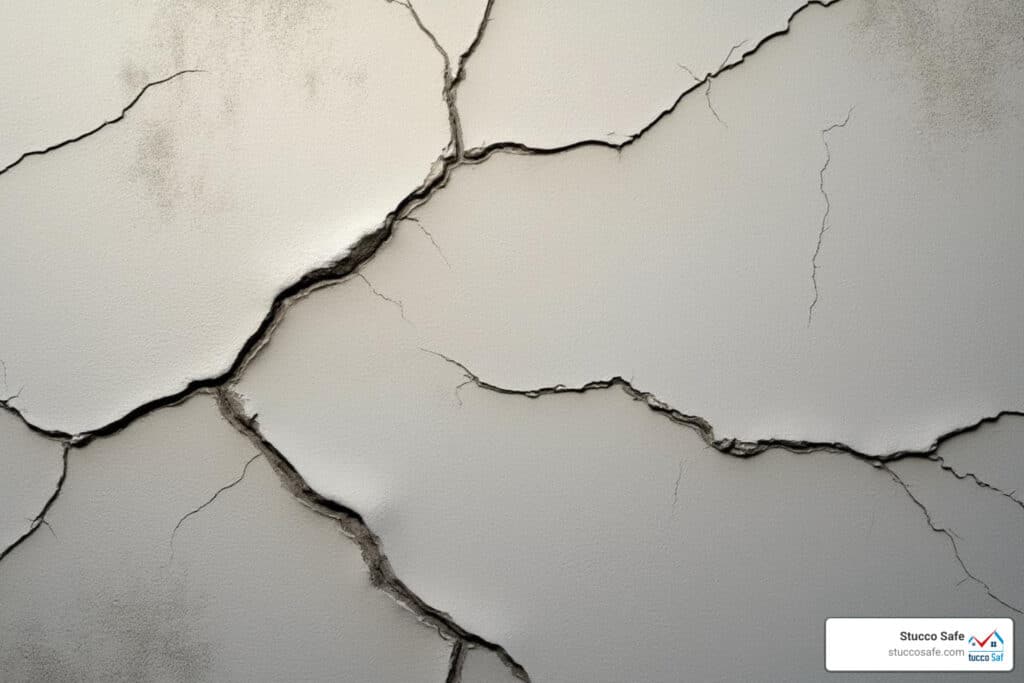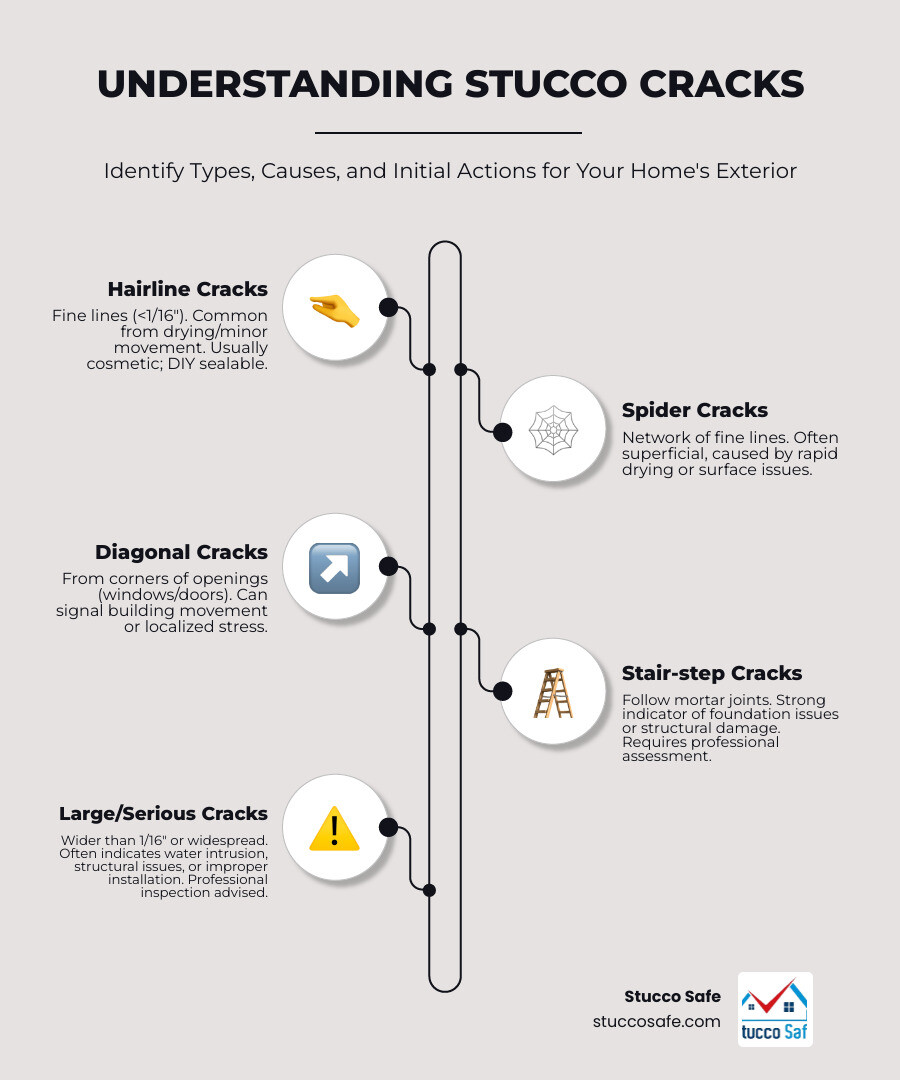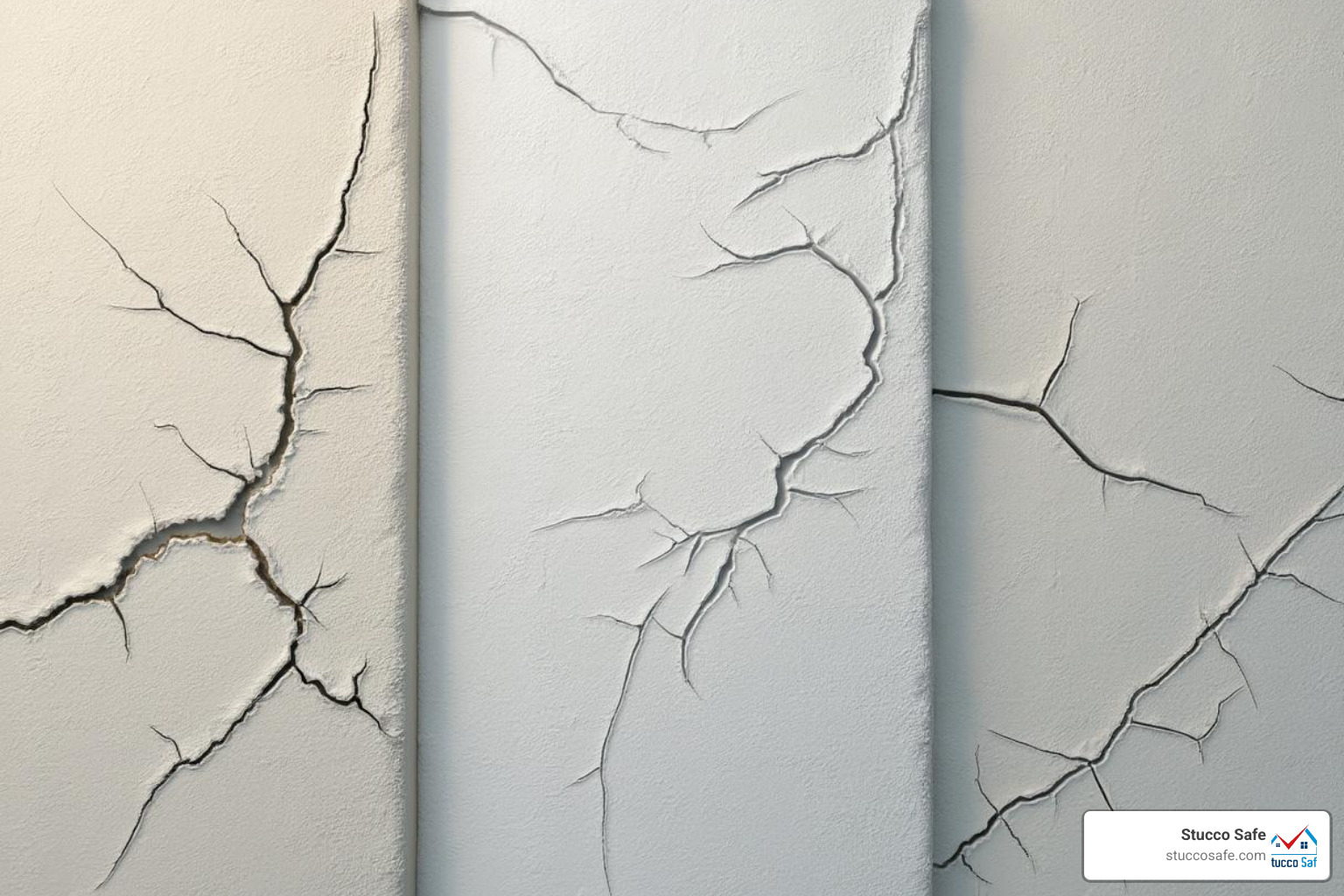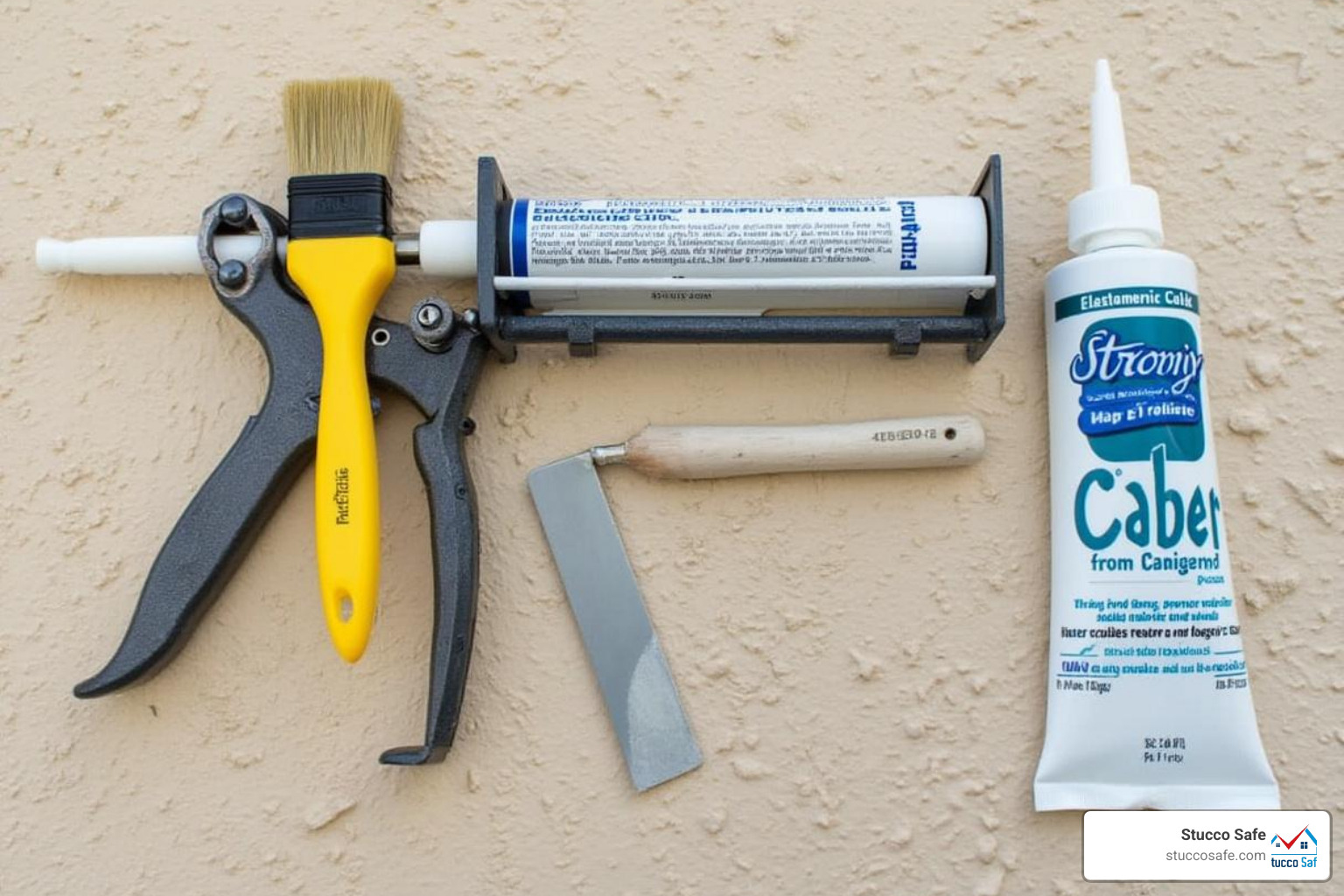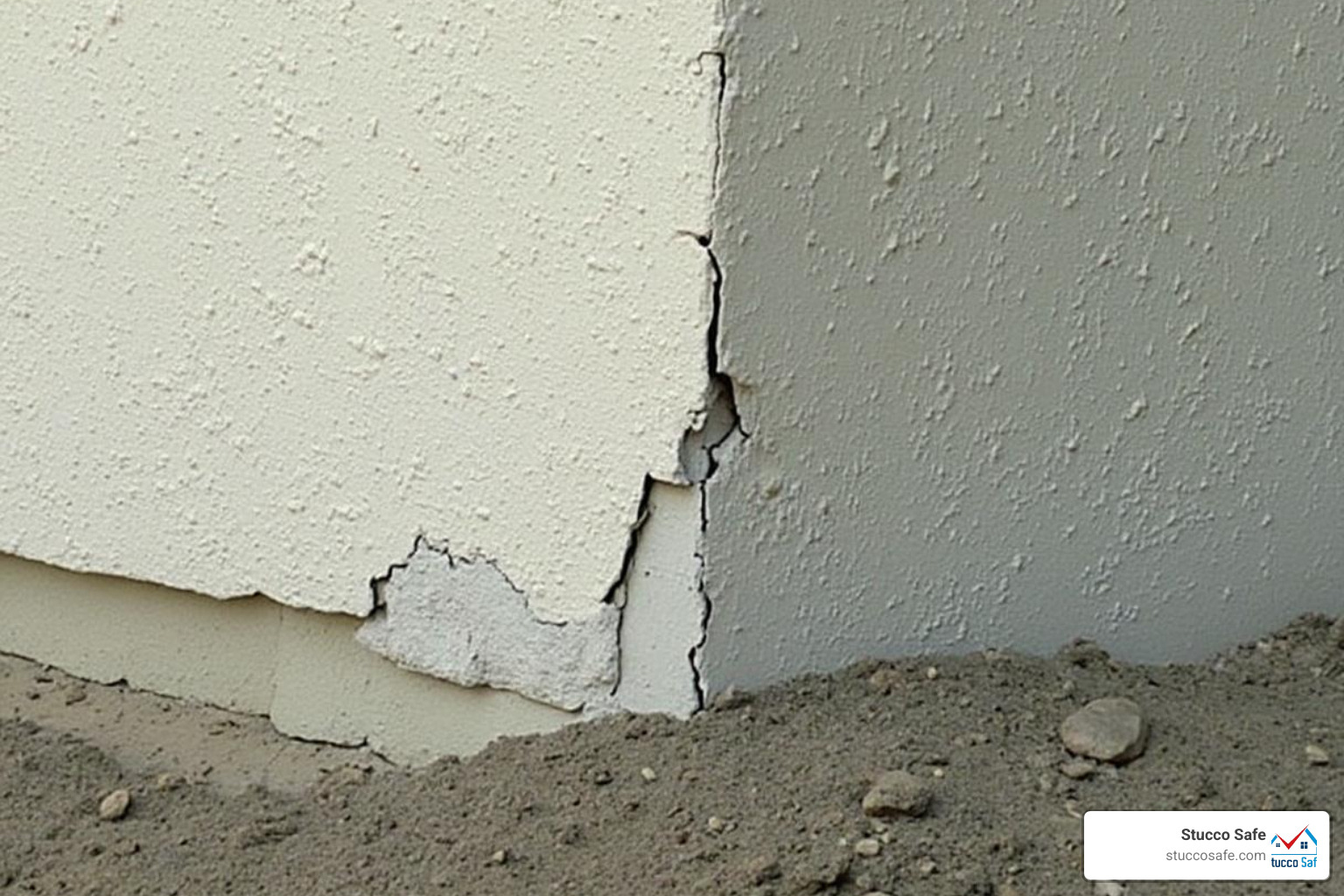Stucco Cracks: 5 Quick Fixes
Understanding Stucco Cracks: Your Guide to a Safe Home
When you see stucco cracks on your home, it’s important to know what you’re dealing with. Small, hairline cracks (less than 1/16 inch wide) are common as stucco cures and can often be a DIY repair. However, larger cracks (wider than 1/16 inch) can signal deeper issues like water damage or foundation problems that require a professional.
Stucco is a beautiful and durable finish, but it’s a cement-based product, and some cracking is inevitable. The key is understanding whether a crack is a minor cosmetic issue or a red flag for hidden damage.
As Gabe Kesslick, founder of Stucco Safe, I’ve spent years helping homeowners in Southeastern Pennsylvania, New Jersey, and Delaware address stucco cracks. My background as an EDI and BESI Certified Inspector provides deep insight into these common issues.
Explore more about stucco cracks:
Step 1: Identify the Type and Cause of Your Stucco Cracks
Understanding the specific type of crack you’re seeing can tell you a lot about its cause and severity. Because stucco is a cement-based product, it is prone to stucco cracks. The first step is to identify what kind you have.
What are the most common types of stucco cracks?
Let’s break down the usual suspects you might find:
- Hairline Cracks: The most common and least concerning type, measuring less than 1/16 of an inch wide (the thickness of a credit card). They often appear as new stucco cures but can allow moisture to enter.
- Spider Cracks: Also called “crazing,” these are shallow, interconnected cracks that look like a spiderweb. They often result from the stucco drying too quickly or an improper mix. They are generally cosmetic but can still let water in.
- Pattern Cracks: These appear in straight lines or “stair-step” patterns, often hinting at issues with the underlying sheathing or lath installation.
- Diagonal Cracks: Often found near windows and doors at a 45-degree angle. If wider than 1/16 of an inch, they are strong indicators of house settling or structural movement.
- Stair-Step Cracks: A type of diagonal crack that follows the mortar lines on masonry (like cinder blocks). These are a clear sign of underlying structural movement or foundation issues.
As a rule of thumb, cracks smaller than 1/16 of an inch are often cosmetic, while those larger than 1/16 of an inch usually point to more serious problems that warrant a professional look. You can dive deeper into various issues on our Stucco Siding Problems page.
Why does stucco crack in the first place?
Stucco cracks are often a natural result of various factors:
- Drying and Curing: As cement-based stucco dries and hardens, it naturally shrinks, which can cause small, superficial cracks. This is a normal and expected part of the process.
- Building Movement: Homes settle over time and expand and contract with temperature changes. Since stucco is rigid, this movement can cause it to crack.
- Foundation Settlement: If a home’s foundation settles unevenly, it puts stress on the entire structure, leading to serious diagonal or stair-step cracks.
- Moisture Changes: Water can cause the underlying wood sheathing to swell and shrink, leading to cracks. Water trapped behind the stucco can also weaken the base coat.
- Improper Installation: This is a major factor in many severe stucco issues. Common mistakes include an inadequate mix, insufficient thickness, improper curing, missing control joints, poor lath installation, and a lack of proper flashing and drainage.
As the Stucco Manufacturers Association notes in their Stucco Cracking Overview with General Repair Guidelines, even perfectly installed stucco can crack. Understanding these causes is the first step toward finding a solution.
Step 2: How to Repair Minor Stucco Cracks Yourself
If you’ve identified your stucco cracks as minor (hairline or small spider cracks less than 1/16 inch wide), you can often repair them yourself. Addressing these small cracks promptly is crucial to prevent moisture intrusion that can lead to bigger problems.
A Simple Guide to Fixing Hairline Cracks
Repairing hairline cracks is a straightforward process:
- Clean the Crack: Use a stiff brush to clear the crack and surrounding area of any loose debris, dirt, or old paint to ensure the new material adheres properly.
- Apply Flexible Sealant: Use a high-quality, paintable, elastomeric masonry caulk. This material can stretch and flex with your home’s movement, preventing the crack from reappearing. Apply a steady bead directly into the crack.
- Dabbing for Texture: While the caulk is wet, use a gloved finger or damp sponge to gently dab the caulk. This helps match the texture of the surrounding stucco, making the repair less noticeable.
- Curing Time: Allow the caulk to cure fully according to the manufacturer’s instructions.
- Painting the Patch: Once cured, paint over the repaired area to ensure a consistent look.
You can find more info about repairing small cracks on our website.
What materials should I use for a lasting repair?
The choice of material is critical for a durable repair.
- Flexible Sealants (Elastomeric Caulk): This is our top recommendation for most small stucco cracks. Look for products labeled “elastomeric masonry caulk” or “polyurethane-based caulk,” as they are designed to stretch and compress with the building’s natural movement.
- Paintable Caulk: Always choose a paintable caulk to ensure the repair blends in seamlessly with the rest of the wall.
- Avoiding Rigid Patches: We advise against using rigid stucco patch compounds for small cracks. They don’t accommodate movement and tend to re-crack in the same spot.
Step 3: Know When a Crack Is a Serious Warning Sign
While small stucco cracks are often manageable, it’s crucial to recognize when a crack is a serious warning sign. Larger, more significant cracks can point to deeper issues that require immediate professional attention to protect your home’s structural integrity and value.
Can stucco cracks indicate foundation problems?
Yes, absolutely. Certain crack patterns are strong indicators of issues with your home’s foundation. Look for these warning signs:
- Diagonal Cracks: These often appear at a 45-degree angle around windows and doors and can point to significant foundation settling.
- Stair-Step Cracks: Cracks that follow the mortar joints on a masonry wall are a classic sign of foundation movement.
- Wide Cracks: Any crack wider than 1/16 of an inch is a cause for concern. If the crack is wider at the top or bottom, it suggests structural movement.
- Misaligned Edges: If the stucco on either side of a crack is no longer flush, it’s a clear sign of serious movement.
- Other Signs: Look for accompanying issues like interior drywall cracks, sticking doors and windows, or sloped floors.
If you notice these signs, it’s important to get a professional assessment.
What happens if I ignore the problem?
Ignoring serious stucco cracks can lead to much bigger, more expensive problems.
- Moisture Intrusion: This is the biggest threat. Cracks create pathways for water to get behind the stucco, where it can reach the underlying sheathing and framing.
- Compromised Building Envelope: A broken exterior “skin” can lead to serious secondary damage:
- Wood Rot: Moisture will rot the sheathing and structural framing of your home.
- Mold Growth: Trapped moisture creates a perfect breeding ground for mold and mildew inside your walls, which is a potential health risk.
- Pest Infestation: Cracks provide easy entry for insects and rodents attracted to damp wood.
- Decreased Property Value: Obvious stucco damage and the underlying issues it represents can significantly lower your home’s curb appeal and market value.
- Cost Escalation: A small crack can quickly lead to tens of thousands of dollars in damage if moisture causes widespread rot or mold. By the time you see bubbling stucco, the damage underneath is likely extensive. Learn more on our Bubbling Stucco: A Guide to Prevention and Repair page.
Ignoring serious stucco cracks is a gamble with your most important investment. Early detection and action can save you from significant expense.
Step 4: Take Action with Professional Stucco Inspection
When you suspect your stucco cracks are more than just cosmetic, it’s time to call a professional. A professional stucco inspection provides protection for your home and ultimate peace of mind. At Stucco Safe, we help homeowners in Southeastern Pennsylvania, New Jersey, and Delaware uncover hidden issues and ensure their homes remain strong.
Why should I hire a professional inspector?
While DIY is great for minor fixes, a professional inspector is indispensable for serious issues.
- Identify the Root Cause: An inspector doesn’t just see a crack; they investigate why it’s there, whether it’s from an installation error, hidden moisture, or building movement. Fixing the underlying problem is key.
- Hidden Moisture Detection: We use specialized tools like high-accuracy moisture meters and infrared thermography to find moisture lurking behind your stucco long before it becomes visible.
- Structural Integrity Assessment: Certified inspectors can spot signs of structural stress and advise if a structural engineer is needed.
- Peace of Mind: Knowing the true health of your stucco system and having a clear action plan is priceless, whether you’re buying, selling, or maintaining your home.
- Detailed Repair Plan: You’ll receive a comprehensive report with specific recommendations, giving you a roadmap for making informed decisions with contractors.
As our founder, Gabe Kesslick, an EDI Certified Stucco Inspector, states, inspections should be done by a certified professional, not a standard home inspector. We provide unbiased reporting because we don’t perform repairs. Professional stucco inspections typically range from $495 to $1595 or more for very large homes. Learn more on our What is a Stucco Inspection? page.
What does an invasive stucco test involve?
When we suspect hidden moisture, we may recommend an invasive stucco test. This process is minimally intrusive and highly effective.
We use specialized moisture meters to check the health of the wood framing and sheathing behind your stucco. The process involves drilling tiny, 3/16-inch holes in strategic, inconspicuous locations. Through these small openings, we insert probes to take direct moisture readings and perform a visual inspection of the underlying structure.
These moisture readings confirm if water is getting where it shouldn’t be, uncovering hidden damage that is impossible to spot from the outside. This forensic approach gives you a detailed, honest report on your stucco system’s health. For more insights, explore our More info about Invasive Stucco Testing page.
Frequently Asked Questions about Stucco Cracks
We understand that stucco cracks can raise a lot of questions. Here are some of the most common inquiries we receive from homeowners in Southeastern Pennsylvania, New Jersey, and Delaware.
Is it normal for new stucco to crack?
Yes, it is completely normal for new stucco to develop small hairline cracks. These are often called “shrinkage” cracks and are an inherent characteristic of cement-based products as they dry and cure. You might notice these tiny cracks (less than 1/16 of an inch wide) within the first 30 days after installation. While they are not typically a structural concern, we recommend sealing them as part of regular home maintenance to prevent moisture entry.
How much does it cost to repair stucco?
The cost to repair stucco cracks varies widely depending on the severity of the crack and the underlying cause.
- DIY Minor Repairs: For small hairline cracks, you can expect to spend under $50 on a tube of quality elastomeric caulk and some paint.
- Average Professional Repairs: For surface-level issues without significant hidden damage, professional repairs typically range from $500 to $1,000.
- Extensive Repairs: If cracks indicate hidden water damage, wood rot, or structural issues, the cost can range from $800 to $8,500 or more. The final price depends on the extent of the damage and the complexity of the remediation.
- Professional Stucco Inspection: Before a major repair, a professional inspection is a wise investment. Our inspections range from $495 to $1595+, depending on home size, and provide an accurate diagnosis to ensure the repair solves the root problem.
Addressing stucco cracks early can save you a significant amount of money by preventing minor issues from becoming major disasters.
How can I prevent future stucco cracks?
While some cracking is natural, you can take key steps to minimize future stucco cracks.
- Ensure Proper Installation: The best prevention is correct initial installation. This includes proper thickness, the right material mix, and, most importantly, the inclusion of flexible control joints to allow the stucco to expand and contract without cracking randomly.
- Manage Water: Ensure your gutters and downspouts direct water away from the foundation. The ground should also slope away from your home. Keep the weep screed at the bottom of your stucco wall clear of debris and soil to allow for proper drainage.
- Seal Openings: Windows and doors are common failure points. Ensure they are properly flashed and sealed with a high-quality, flexible caulk to prevent moisture intrusion.
- Perform Regular Maintenance: Conduct an annual inspection of your stucco. Promptly seal any new hairline cracks with flexible caulk. Repainting your stucco every 7-10 years also helps maintain its protective qualities. For more guidance, visit our Stucco Exterior Maintenance page.
Conclusion
We’ve learned that while stucco cracks are common, they are not all created equal. Knowing the difference between a minor hairline crack and a serious warning sign is your most powerful tool as a homeowner.
Small, cosmetic stucco cracks are often a simple DIY fix with a bit of flexible caulk. However, larger cracks—those that are wide, diagonal, or form stair-step patterns—are your home’s way of signaling a deeper problem. Ignoring them can lead to moisture intrusion, wood rot, and potential structural issues.
This is where a professional assessment is invaluable. At Stucco Safe, we serve homeowners in Southeastern Pennsylvania, New Jersey, and Delaware, using advanced forensic testing to uncover the root cause of stucco cracks and any hidden damage. Our unbiased reports provide clear answers and a solid plan to protect your investment.
Don’t let stucco cracks compromise your home’s safety and value. Being proactive is the smartest move to keep your home healthy and beautiful for years to come.
Schedule your professional stucco inspection today and let us help you protect your home.

